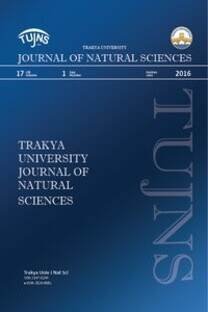Hibernation and postnatal development of the mouse-tailed dormouse, Myomimus roachi reared outdoor's in a cage
Bu çalışmada araziden canlı yakalanan ve dış ortam kefesinde yetiştirilen yer yediuyuru (Myomimus roachi)'nun kış uykusu ve postnatal gelişimine ait ilk bilgiler verilmiştir. Kış uykusuna Ekim ayının ikinci yarısında girerler ve Nisan ayının ilk yarısında da uykudan kalkarlar. 19.Mayis.1988 ve 1. Haziran. 1988'de olan doğumlarda sırasıyla 6 (4 erkek ve 2 dişi) ve 5 (2 erkek ve 3 dişi) yavru meydana gelmiştir. 11 yavrunun doğum günündeki (0.gün) ortalama vücut ağırlığı 2,1 gramdır (dağılım =1,9-2,4). Tüm yavrular 12. günde yürüdüler, gözler 15.-19. günlerde, kulaklar ise 12.-19. günlerde açıldı. İlk katı besin almaları ve yuvadan dışarı çıkmaları aynı anda 19.-22. günlerde oldu. Ortalama vücut ağırlıkları 9,6 grama ulaştığında 29.-31. günlerde sütten kesildiler. Doğumdan yaklaşık 120 gün sonra ortalama ergin vücut ağırlığına eriştiler.
Dışortam kafesinde yetiştirilen Myomimus rochi' lerde kış uykusu ve postnatal gelişim
The first information on hibernation and postnatal development of mouse-tailed dormouse (Myomimus roachi), live-trapped in the field reared and caged outdoors, is reported herein. They go into hibernation in the second half of November and arouse in the first half of April. They hibernate underground in hibernacula without nesting materials. Parturitions occurred in May 19, 1998 and in June 01, 1998, and litter sizes were 6 (4 males and 2 females) and 5 (2males and Sfemales) respectively. For eleven pups, the average body weight was 2.1 g (range= 1.9-2.4 g) at day 0. All pups walked at day 12, and their eyes and ears had opened at day 15-19 and at day 12-19 respectively. First solid food intake and movement from the breeding nest co-occurred at day 19-22 with an average body weight of 7.67 g. They were weaned at day 29-31 when they had reached an average body weight of 9.6 g. The average adult weight was attained at the age of ca. 120 days after birth.
___
- Angermann, R. Ein weiterer Fundort von Myomimus personatus Ognew, 1924. – Z. Säugetierkde., 31: 411; Hamburg – Berlin, 1966. Bate, D. M. A. Systematic: With descriptions of new species,: 157-233. – In: Garrod, D. A. E., Bate, D. M. A.: mThe stone age of Mount Carmel, 1. – xii + 240 p.; Oxford (Clarendon Press), 1937. Corbet, G. B. , Morris, P. A. A collection of recent and subfossil mammals from southern Turkey (Asia Minor), including the dormouse Myomimus personatus. – J. Nat. Hist., 4: 561-569; London, 1967. Haas, G. (In Neuville R., Le Paléolithique et le Mésolithique du Desert de Judée) Remarques sur la Microfaune de Mammifères de la Grotte d’Oumm Qatafa Archives Inst. Paleont. Hum. Mem. 24, 1951. Haas, G. Some Remarks on Philistomys roachi Bate. Ann. Mag. nat. Hist. [13] II, 688-690, 1960. Kurtonur, C. New records of Thracian mammals. – Säugetierkdl. Mitt., 23: 14-16; München, 1975. Kurtonur, C., Özkan, B. New records of Myomimus roachi (Bate 1937) from Turkish Thrace (Mammalia: Rodentia: Gliridae). - Senckenbergiana biol., 71: 239-244; Frankfurt am Main, 1991. Kuss, S. E., Storch, G. Eine Säugetierfauna (Mammalia: Artiodactyla, Rodentia) des älteren Pleistozäns von der Insel Kalymnos (Dodekanés; Griechenland). – N. Jb. Geol. Paläont., Mh., 1978: 206-227; Stuttgart, 1978. Lee, P. C., Majluf, P and Gordon, I. J. Growth, weaning and maternal investment from a comparative perspective. J. Zool., Lond. 225, 99-114, 1991. Minato, S. Physical and behavioral development of the Japanese Dormouse, Glirulus japonicus (Rodentia, Myoxidae). – Mammalia, t. 60, nº 1, 35-51, 1997. Mursaloğlu, B. New records for Turkish rodents (Mammalia). Commun. Fac. Sci. Univ. Ankara, (C) 17: 213-219; Ankara, 1973. Pechev, T., Dinev, T. S., Anguelova, V. I. Myomimus personatus Ogn. (Mammalia Myoxidae) – a new rodent in the fauna of Bulgaria. – Zool. Zh., 39: 784-785; Moskva, 1960. Pechev, T., Anguelova, V., Dinev, T. Études sur la taxionomie du Myomimus personatus (Ognew, 1924) (Rodentia) en Bulgaria. – Zool. Zh., 28: 419-428; Paris, 1964. Rossolimo, O. L. Taxonomic status of the mouse like dormouse Myomimus (Mammalia, Myoxidae) from Bulgaria. – Zool. Zh., 55: 1515-1525; Moskva, 1976. Storch, G. Eine mittelpleistozäne Nager-Fauna von der Insel Chios, Ägäis (Mammalia: Rodentia). – Senckenbergia biol., 56: 165-189; Frankfurt a. M. 1975. Storch, G. Myomimus roachi (Bate, 1937) – Mausschläfer,: 238-242. – In: Niethammer, J., Krapp, F. (Hrg): Handbuch der Säugetiere Europas, 1. – 476 p.; Wiesbaden (Akademische Verlagsgesellschaft), 1978. Storch, G. Eine jungpleistozäne/altholozäne Kleinsäuger-Abfolge von Antalya, SW-Anatolien (Mammalia, Rodentia). – Z. Säugetierkde., 53: 76-82; Hamburg – Berlin, 1988. Vogel, P. Hibernation of recently captured Muscardinus, Eliomys and Myoxus: a comparative study. - Nat. Croat., Vol. 6 No: 2, 217-231, 1997. Wahlert, J. H., Sawitzke, S. L., Holden, M. E. Cranial anatomy and relationshisps of dormice (Rodentia, Myoxidae). - American Museum Novitates, 3061: 1-32, 1993.
- ISSN: 1302-647X
- Yayın Aralığı: Yıllık
- Başlangıç: 2018
- Yayıncı: -
Sayıdaki Diğer Makaleler
Dormice in the diet of owls in the Middle East
An attempt to estimate the size and density of Dryomys nitedula population in the Bialowieza Forest
Wojciech K. NOWAKOWSKI, Pawel BORATYNSKI
Density and breeding of Muscardinus avellanarius L., 1758 in woodlands of Sicily
Maurizio SARA, Giulia CASAMENTO, Antonio SPINNATO
Dormouse associations in Slovenia-A new approach to an old tradition
Boris KRYSTUFEK, Werner HABERL
Ebru BURULDAĞ, Cengiz KURTONUR
Morphological patterns and evolutionary pathways of the middle ear in dormice (Gliridae, Rodentia)
Ebru BURULDAĞ, Cengiz KURTONUR
Weight changes of the comon dormouse (Muscardinus avellanarius L.) during the year in Lithuania
